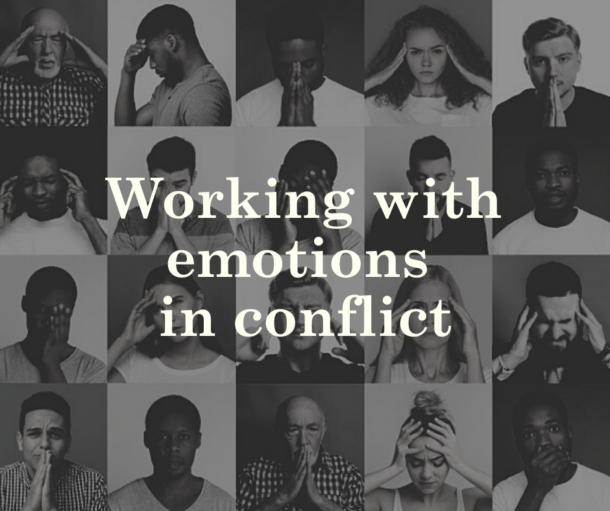One of the core techniques we are taught as mediators and coaches is that when a person expresses their emotions (either directly or indirectly) we should “reflect them back”.
Reflecting back a person’s emotions is supposedly helpful for showing that you understand how the person is feeling, validating the person’s emotional response, building rapport, demonstrating empathy, and providing the person an opportunity to clarify their emotions (to themselves and others).
The technique of reflecting back another’s emotions assumes that we are able to understand another person’s emotions. However, recently, emotions researchers like Lisa Feldman Barrett question this basic assumption. If this challenge is accepted, then perhaps we should reconsider whether and how we should attempt to reflect back what another person is feeling.
Techniques for reflecting back emotions

We can reflect in a simple literal way (transformative mediators call this “mirroring” when they use the same words and tone as the person they are reflecting) or we can summarise or paraphrase and perhaps also add information about what we think the underlying cause or meaning of those feelings might be for the other person.
With the transformative mirroring approach, so long as we reflect the person’s actual words and tone fairly closely, it doesn’t matter whether we actually understand what those words and tone mean to that person. We are simply giving them an opportunity to reflect on their own emotional expression by having it mirrored back to them. It is up to them to decide the meaning and what to do or say next.
However, when we are more active in our reflection, for example when we try to paraphrase, summarise or expand on what the person is saying, we risk getting it wrong. This isn’t necessarily a bad thing, as in a supportive context this can act as an invitation for the person to clarify and elaborate. But sometimes our mismatch can be distracting or divert the client’s attention and train of thought from their original focus.

Can we ever reflect back a person’s emotions accurately?

In her book How Emotions are Made, Lisa Feldman Barrett says:
“Emotions are not expressed, displayed, or otherwise revealed in the face, body, and voice in any objective way… You cannot recognise or detect anger, sadness, remorse, or any other emotion in another person – you can only guess, and some guesses are more informed than others.”
Emotion perception involves a process of inference. We infer the person’s emotions based on our assessment of their desires and intentions, personalities, goals and motivations, and the surrounding context.
Our perception of other people’s emotions is sometimes more based on what’s going on for us, than what’s going on for them! We perceive others as happy, sad or angry by applying our own emotion concepts to their moving faces and bodies. It feels like we are detecting, but we are actually constructing a perception, based on multiple factors (many of which are internal to us).

Some people are naturally more skilled at interpreting others’ emotional expressions, due to their life experiences or social training. For example, women are often better at recognizing how another person is feeling than men. People who have experienced violence during their childhood are also typically highly skilled at recognizing nuances of changes in another’s emotional experience, with special sensitivity to signs of anger. The ability to recognize people’s emotional expressions is also a skill that can be developed with training.
Life experience and training can help us to make a more informed guess, but we can almost never be certain what another person is feeling. Lisa Feldman Barrett says that it’s not possible to say whether or not we are “accurate” in our perception – rather we can ask whether two people agree with their perception of an emotion, or whether a perception is consistent with some norm.
Reflecting back emotions in conflict resolution processes
Let’s consider how this might work in a conflict context, when a practitioner is reflecting back to a client how they are feeling. Many clients do not explain their emotions with much nuance or emotional granularity. For example, they state that they were “angry” or “furious” but without further elaboration, or they simply imply an emotional experience by their words, tone of voice, body language or facial expression. In this situation, there is considerable room for misunderstanding.
For example, I might reflect back to a client “It seems like you were really angry”. However, it’s quite likely that my personal experience of anger (even in a similar situation) is quite different from that of my client. Every individual’s experience of emotion varies significantly based on their personality, upbringing, history, culture, context, and many other factors.
When I say something like “Sounds like you are really angry”, my client may interpret this to mean “I understand that you are angry, and I understand how anger feels to you and how you experience it, and what lead you to experience anger in this situation”. However, this is clearly overstating what I actually understand about my client’s experience.
Does this matter? So long as my client feels “heard and understood”, does it matter that they may not be actually understood, at least in any nuanced way? Perhaps the feeling of rapport and empathy is enough in itself.
I believe, however, that we can do more.
I wonder whether, instead of simply reflecting back a person’s emotions, we can invite a more in-depth conversation about them. This means that instead of being able to “take” their perspective, we can invite them to share it with us in a more detailed, nuanced way. In doing so, we can also support them to develop their own emotional granularity, to reflect on their emotions, and to practice expressing them in a more complex way.

Would you like to know more about how emotions impact on conflict and conflict resolution?
Would you like to learn strategies to support people to respond effectively to other people’s emotions so that they can engage in conflict in a constructive way?

Check out CCI Academy’s new Working with Emotions in Conflict fully flexible online course. It includes over 20 hours of video lessons, plus additional written content and activities to apply your learning.
We are also offering you the opportunity to try Module 1 of the course (including over two hours of video content about Understanding Emotions and a downloadable workbook) for just $97 so you can try it out before committing to the whole course. Click here to access this special trial offer: https://www.conflictmanagementacademy.com/trial-module1-wwe/

